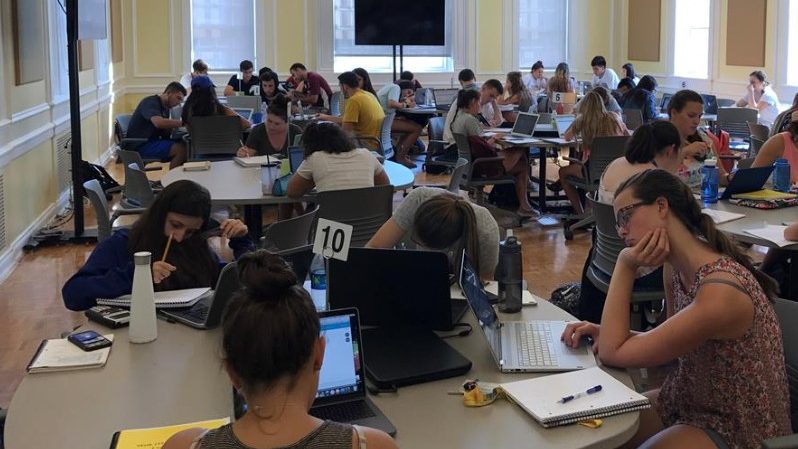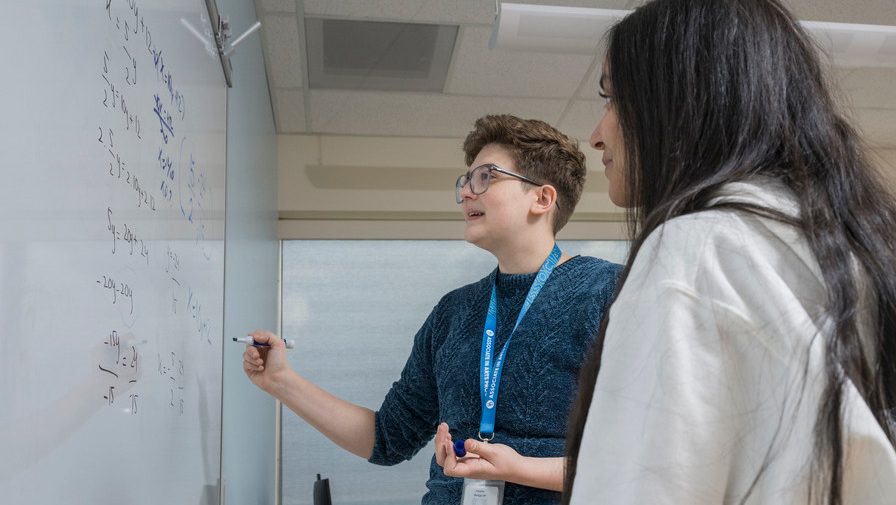
Math 113
Math 113 - Contemporary Mathematics
The information presented here is intended to describe the course goals for current and prospective students as well as others who are interested in our courses. It is not intended to replace the instructional policies and course materials presented in class. The following information applies to the Newark campus. For information about this course offered at the satellite campuses, see the contacts at the bottom of this web page.
Every effort is made to update this information on a routine basis. However, if you have questions about enrollment, course materials, and pre-requisite skills, please check with your adviser or instructor.
The most updated Course Description can be found at the UD Course Description Search. Information on the sections currently offered can be found at the UD Course Search. More information can be found on the departmental syllabus.
How can I save time delivering an advertisement to all houses in a development? How does mathematics assist in developing a plan to schedule priorities for event planning initiative? How is statistics used to describe the variation in income among college graduates? How can mathematics assist in planning election strategy?
This course is designed to help answer these types of questions (and others) and prepare students in non-technical majors for college work, for their careers, and for mathematical challenges of life in general. At the end of the course, students should know how mathematical skills and concepts are used in a variety of topics and issues and how some basic mathematical strategies are used to analyze issues encountered in everyday life.
This course is a terminal math course – it does not prepare students for another math course. The course grade will not fulfill enrollment requirements for any other math course. Students whose majors require additional mathematics should enroll in other math courses such as Math 114 or Math 115.
Topics will include the following. Order of topics will vary from semester to semester.
1. Statistics (required):
- Collecting data and surveys
- Analyzing data –including histograms, quartiles and the five number summary, ranges and standard deviation.
- Probability – including sample spaces, events, permutations and combinations, probabilities.
- Normal distributions
At least four topics are chosen from the remaining topics.
2. Management science
- Euler and Hamilton circuits and algorithms to solve a variety of problems involving these circuits.
- Networks and trees.
- Scheduling including algorithms to determine the critical path.
3. Social Choice
- Basic elements of an election and a variety of methods for determining the outcome of an election.
4. Growth Models
- Linear, exponential and logistic growth models.
5. Finance
- Percentages, simple and compound interest.
- Savings and debt.
6. Shape and Form
- Symmetry (reflections, rotations, translations), patterns
- Fractal geometry
- Fibonacci numbers, golden ratio.
7. Coding Information
- Identification numbers
- Encoding information.
8. Logic
- Statements and quantifiers.
- Truth tables.
- Logical arguments.
9. Set theory
- Sets, subsets, and set operations.
- Venn Diagrams.
- Infinite sets
10. Numeration systems
- Base number systems
11. Measurement
- Converting units.
- Measures of area, volume, capacity, weight, and temperature.
In order to succeed in this course, students must have some basic arithmetic skills. For instance, students should know how to work with fractions and percents.
The textbook usually used for this course is Excursions in Modern Mathematics by Peter Tannenbaum, published by Pearson. However, students should wait until the first day of class to ensure the appropriate textbook and other course materials are purchased.
A calculator is required. You will need a calculator with basic arithmetic operations, and exponential (exp) and logarithm (log) functions. Also, it must be able to determine mean, median, and standard deviation on a data set. Older graphing calculators such as the TI-81 would be sufficient. Graphing calculators such as the TI-83 or TI-83 plus are optional.
This course is offered in fall and spring semesters. In most cases, the course meets three hours per week in either a MWF or Tues./Thur. course format. Assessment activities generally include tests, quizzes, group and individual work and projects. The number of exams can vary but generally three common exams and a final exam are administered. Common exams may be administered during the evenings and the final exam is cumulative. An example can be found in the sample or current syllabus.
See Course Sections for sections currently offered.
There are several campus resources that provide additional assistance.
- Mathematical Sciences Learning Laboratory (MSLL) Open Lab: MSLL Open Lab provides free tutorial support for this course. The lab is staffed by qualified undergraduate students. This is a drop-in site – no appointment is needed. Students can work on their math homework, study for a math quiz or exam, and receive free tutorial assistance. More information can be found at the webpage: MSLL Open Lab
- Office of Academic Enrichment: Located at 148-150 South College Avenue, this site provides a number of different course resources for students. Please visit their website for more information.
Students enrolled at other campuses should contact the math faculty for the specific campus for additional information about this course.
- Dover Campus: Brad Thompson, bthompso@udel.edu
- Georgetown Campus: Matthew Willis, mjwillis@udel.edu
- Wilmington Campus: Alexia M intos, amintos@udel.edu


